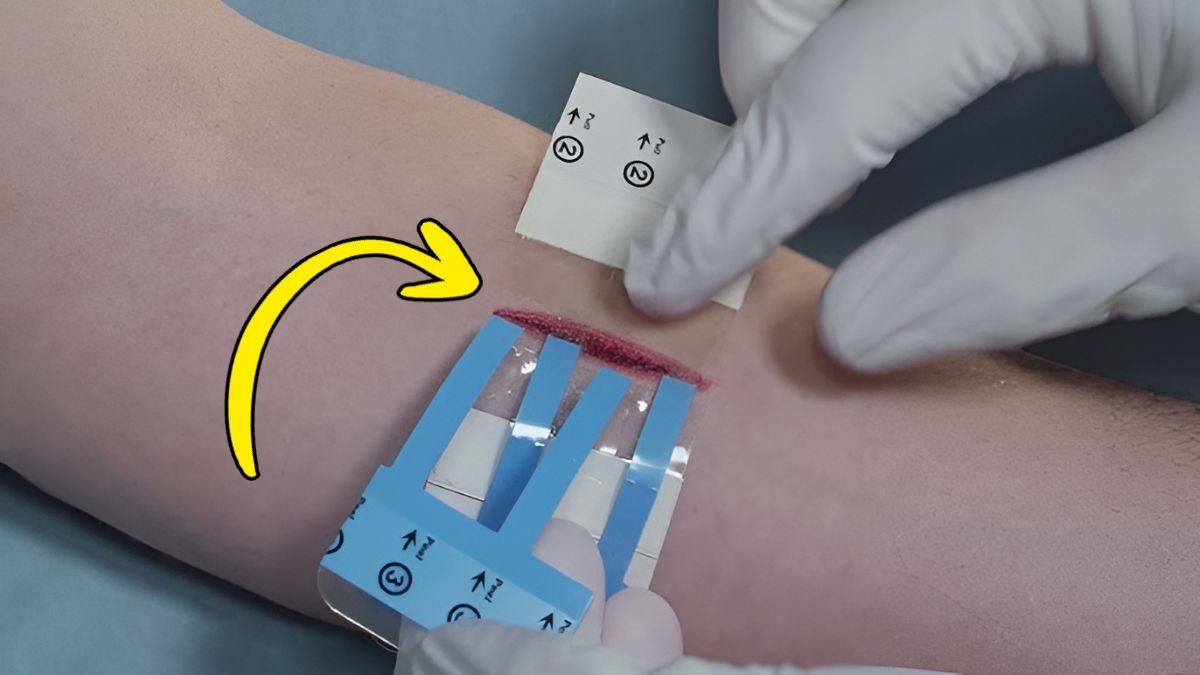Japanese scientists have recently made a groundbreaking discovery in the field of wound treatment that could completely revolutionize medical practices in the future. They have developed a bio-gel bandage that seals cuts and lacerations in seconds, without the need for stitches. This bandage not only seals the wound instantly but also promotes healing with minimal or virtually no scarring.
This new discovery could bring about a major transformation in areas such as emergency medicine, surgery, and field medicine. Where previously deep wounds required stitches or staples to close, this gel can now accomplish the same task in seconds—safely, quickly, and painlessly.
How the Bio-Gel Works
The secret to this gel’s effectiveness lies in its cutting-edge scientific composition. Japanese researchers created it using cross-linked polymers and peptides. These two elements instantly bond with the body’s tissues, even if the wound is bloody or wet.
1. Rapid Adhesion
The gel’s greatest advantage is its ability to adhere to the wound surface in seconds. Unlike traditional sutures or surgical stitches, it doesn’t require a needle, thus reducing the risk of infection or pain.
2. Watertight and Flexible
This bio-gel forms a strong and flexible layer over the wound that is completely waterproof. This means it stops bleeding almost immediately and also prevents external bacteria or dust from entering the wound.
3. Biodegradable
This gel is completely biodegradable. This means that once the wound has healed, the body gradually and naturally absorbs it. This eliminates the need for removal, relieving patients from the inconvenience of frequent hospital visits.
Key Advantages of this Technology
This bio-gel is not just a scientific achievement; it’s a major step towards making future medical treatments simpler, faster, and painless.
Faster Treatment
- In emergency situations, such as accidents or on the battlefield, where every second counts, this gel can instantly seal wounds. This stops blood loss and significantly accelerates the healing process.
Reduced Scarring and Better Skin Regeneration
- Because this gel doesn’t puncture the skin with needles, scarring is minimal or nonexistent when the wound heals. This can be extremely useful in cosmetic surgery or for treating facial wounds.
Less Pain and Discomfort
- Compared to stitches, this gel is significantly less painful. It’s also easy to apply, providing relief to the patient without any special procedures.
Ease of Use
- This technology is incredibly simple for doctors and paramedics. They simply apply the gel, and the wound seals itself. It doesn’t require much time or expertise.
Other Modern Technologies Replacing Stitches
While this Japanese bio-gel is currently the newest and most advanced discovery, several other technologies have already been developed to close wounds without stitches.
1. Light-Activated Adhesives
- These are adhesives that instantly harden and seal wounds when exposed to UV or other light. For example, an adhesive called MeTro was found in a 2017 study to be able to close wounds in just 60 seconds.
2. Zip-Tie Closure Devices
- Some devices, such as Zip® Surgical Skin Closure, use small adhesive strips that pull the skin together, eliminating the need for stitches.
3. Medical-Grade Glue
- Doctors have long used medical adhesives like Dermabond. It looks similar to household super glue but has a different chemical composition. It is used on small, clean cuts to help wounds heal painlessly.
4. Other Hydrogels
- Other research has developed hydrogels, such as “superskin,” made from clay nanosheets and polymers, which mimic the elasticity of human skin and can accelerate wound healing.
Availability and Future Potential
Currently, some products like Dermabond and ZipStitch are available and in use in the market.
However, light-activated glue and this new Japanese bio-gel are still in the testing phase. It has only been used for animal testing so far.
However, experts believe that in the next few years, this technology could be regularly used in areas such as emergency medicine, military medicine, and plastic surgery. As it undergoes clinical trials, it is expected to become available to the general public in the near future.
Conclusion: A New Era of Wound Treatment
Stitches and surgical staples have long been a part of medicine, but now it’s time for a new direction.
Japan’s bio-gel bandage is a revolutionary discovery in this direction, capable of closing wounds in seconds, preventing infection, and healing wounds without leaving scars.
This discovery is not only a major step forward in medical science, but it also offers a glimpse into future treatments where healing will be faster, easier, and painless.
FAQs
Q. What is the new Japanese bio-gel bandage?
A. It’s a hydrogel-based bandage developed by Japanese scientists that seals wounds in seconds without the need for stitches.
Q. How does the bio-gel work?
A. It instantly bonds with human tissue, even in wet or bloody conditions, creating a watertight and flexible seal that stops bleeding.
Q. Is the bio-gel safe for the body?
A. Yes. The gel is biodegradable, meaning the body naturally absorbs it as the wound heals.
Q. When will the bio-gel be available for public use?
A. Currently, it’s still in the testing phase and has only been used in animal studies.
Q. What are the main benefits of using this bio-gel?
A. It reduces pain, prevents scarring, and speeds up wound closure compared to traditional stitches.
